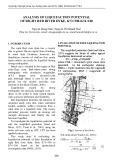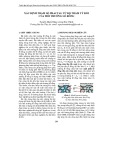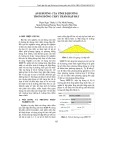
IMC2007, Blagoevgrad, Bulgaria
Day 1, August 5, 2007
Problem 1. Let fbe a polynomial of degree 2 with integer coefficients. Suppose that f(k) is divisible
by 5 for every integer k. Prove that all coefficients of fare divisible by 5.
Solution 1. Let f(x) = ax2+bx +c. Substituting x= 0, x= 1 and x=−1, we obtain that 5|f(0) = c,
5|f(1) = (a+b+c) and 5|f(−1) = (a−b+c). Then 5|f(1) + f(−1) −2f(0) = 2aand 5|f(1) −f(−1) = 2b.
Therefore 5 divides 2a, 2band cand the statement follows.
Solution 2. Consider f(x) as a polynomial over the 5-element field (i.e. modulo 5). The polynomial has
5 roots while its degree is at most 2. Therefore f≡0 (mod 5) and all of its coefficients are divisible by 5.
Problem 2. Let n≥2 be an integer. What is the minimal and maximal possible rank of an n×nmatrix
whose n2entries are precisely the numbers 1,2,...,n2?
Solution. The minimal rank is 2 and the maximal rank is n. To prove this, we have to show that the rank
can be 2 and nbut it cannot be 1.
(i) The rank is at least 2. Consider an arbitrary matrix A= [aij ] with entries 1,2,...,n2in some
order. Since permuting rows or columns of a matrix does not change its rank, we can assume that
1 = a11 < a21 <···< an1and a11 < a12 <···< a1n. Hence an1≥nand a1n≥nand at least one of these
inequalities is strict. Then det a11 a1n
an1ann<1·n2−n·n= 0 so rk(A)≥rk a11 a1n
an1ann≥2.
(ii) The rank can be 2. Let
T=
1 2 . . . n
n+ 1 n+ 2 ... 2n
.
.
..
.
.....
.
.
n2−n+ 1 n2−n+ 2 . . . n2
The ith row is (1,2,...,n) + n(i−1) ·(1,1,...,1) so each row is in the two-dimensional subspace generated
by the vectors (1,2,...,n) and (1,1,...,1). We already proved that the rank is at least 2, so rk(T) = 2.
(iii) The rank can be n, i.e. the matrix can be nonsingular. Put odd numbers into the diagonal,
only even numbers above the diagonal and arrange the entries under the diagonal arbitrarily. Then the
determinant of the matrix is odd, so the rank is complete.
Problem 3. Call a polynomial P(x1,...,xk)good if there exist 2 ×2 real matrices A1,...,Aksuch that
P(x1,...,xk) = det k
X
i=1
xiAi!.
Find all values of kfor which all homogeneous polynomials with kvariables of degree 2 are good.
(A polynomial is homogeneous if each term has the same total degree.)
Solution. The possible values for kare 1 and 2.
If k= 1 then P(x) = αx2and we can choose A1=1 0
0α.
If k= 2 then P(x, y) = αx2+βy2+γxy and we can choose matrices A1=1 0
0αand A2=0β
−1γ.
Now let k≥3. We show that the polynomial P(x1,...,xk) =
k
P
i=0
x2
iis not good. Suppose that
P(x1,...,xk) = det k
P
i=0
xiAi. Since the first columns of A1,...,Akare linearly dependent, the first
1

IMC2007, Blagoevgrad, Bulgaria
Day 2, August 6, 2007
Problem 1. Let f:R→Rbe a continuous function. Suppose that for any c > 0, the graph
of fcan be moved to the graph of cf using only a translation or a rotation. Does this imply that
f(x) = ax +bfor some real numbers aand b?
Solution. No. The function f(x) = exalso has this property since cex=ex+log c.
Problem 2. Let x,y, and zbe integers such that S=x4+y4+z4is divisible by 29. Show that S
is divisible by 294.
Solution. We claim that 29 |x, y, z. Then, x4+y4+z4is clearly divisible by 294.
Assume, to the contrary, that 29 does not divide all of the numbers x, y, z. Without loss of
generality, we can suppose that 29 ∤x. Since the residue classes modulo 29 form a field, there is some
w∈Zsuch that xw ≡1 (mod 29). Then, (xw)4+ (yw)4+ (zw)4is also divisible by 29. So we can
assume that x≡1 (mod 29).
Thus, we need to show that y4+z4≡ −1 (mod 29), i.e. y4≡ −1−z4(mod 29), is impossible.
There are only eight fourth powers modulo 29,
0≡04,
1≡14≡124≡174≡284(mod 29),
7≡84≡94≡204≡214(mod 29),
16 ≡24≡54≡244≡274(mod 29),
20 ≡64≡144≡154≡234(mod 29),
23 ≡34≡74≡224≡264(mod 29),
24 ≡44≡104≡194≡254(mod 29),
25 ≡114≡134≡164≡184(mod 29).
The differences −1−z4are congruent to 28, 27, 21, 12, 8, 5, 4, and 3. None of these residue classes
is listed among the fourth powers.
Problem 3. Let Cbe a nonempty closed bounded subset of the real line and f:C→Cbe a
nondecreasing continuous function. Show that there exists a point p∈Csuch that f(p) = p.
(A set is closed if its complement is a union of open intervals. A function gis nondecreasing if
g(x)≤g(y) for all x≤y.)
Solution. Suppose f(x)6=xfor all x∈C. Let [a, b] be the smallest closed interval that contains C.
Since Cis closed, a, b ∈C. By our hypothesis f(a)> a and f(b)< b. Let p= sup{x∈C:f(x)> x}.
Since Cis closed and fis continuous, f(p)≥p, so f(p)> p. For all x > p,x∈Cwe have f(x)< x.
Therefore ff(p)< f(p) contrary to the fact that fis non-decreasing.
Problem 4. Let n > 1 be an odd positive integer and A= (aij )i,j=1...n be the n×nmatrix with
aij =
2 if i=j
1 if i−j≡ ±2 (mod n)
0 otherwise.
Find det A.
1

Solution. Notice that A=B2, with bij =1 if i−j≡ ±1 (mod n)
0 otherwise . So it is sufficient to find
det B.
To find det B, expand the determinant with respect to the first row, and then expad both terms
with respect to the first column.
det B=
0 1 1
1 0 1
1 0 1
1......
...0 1
1 0 1
1 1 0
=−
1 1
0 1
1......
...0 1
1 0 1
1 1 0
+
101
1 0 1
1......
...0 1
1 0
1 1
=−
0 1
1......
...0 1
1 0 1
1 0
−
1
0 1
1......
...0 1
1 0 1
+
1 0 1
1......
...0 1
1 0
1
−
0 1
1 0 1
1......
...0 1
1 0
=−(0 −1) + (1 −0) = 2,
since the second and the third matrices are lower/upper triangular, while in the first and the fourth
matrices we have row1−row3+ row5− · · · ± rown−2=¯
0.
So det B= 2 and thus det A= 4.
Problem 5. For each positive integer k, find the smallest number nkfor which there exist real
nk×nkmatrices A1, A2,...,Aksuch that all of the following conditions hold:
(1) A2
1=A2
2=...=A2
k= 0,
(2) AiAj=AjAifor all 1 ≤i, j ≤k, and
(3) A1A2. . . Ak6= 0.
Solution. The anwser is nk= 2k. In that case, the matrices can be constructed as follows: Let Vbe
the n-dimensional real vector space with basis elements [S], where Sruns through all n= 2ksubsets
of {1,2, . . . , k}. Define Aias an endomorphism of Vby
Ai[S] = (0 if i∈S
[S∪ {i}] if i6∈ S
for all i= 1,2,...,k and S⊂ {1,2,...,k}. Then A2
i= 0 and AiAj=AjAi. Furthermore,
A1A2. . . Ak[∅] = [{1,2,...,k}],
and hence A1A2. . . Ak6= 0.
Now let A1, A2,...,Akbe n×nmatrices satisfying the conditions of the problem; we prove that
n≥2k. Let vbe a real vector satisfying A1A2. . . Akv6= 0. Denote by Pthe set of all subsets of
{1,2,...,k}. Choose a complete ordering ≺on Pwith the property
X≺Y⇒ |X| ≤ |Y|for all X, Y ∈ P.
2

For every element X={x1, x2,...,xr} ∈ P, define AX=Ax1Ax2. . . Axrand vX=AXv. Finally,
write ¯
X={1,2,...,k} \ Xfor the complement of X.
Now take X, Y ∈ P with XY. Then A¯
Xannihilates vY, because XYimplies the existence
of some y∈Y\X=Y∩¯
X, and
A¯
XvY=A¯
X\{y}AyAyvY\{y}= 0,
since A2
y= 0. So, A¯
Xannihilates the span of all the vYwith XY. This implies that vXdoes not
lie in this span, because A¯
XvX=v{1,2,...,k}6= 0. Therefore, the vectors vX(with X∈ P) are linearly
independent; hence n≥ |P| = 2k.
Problem 6. Let f6= 0 be a polynomial with real coefficients. Define the sequence f0, f1, f2,... of
polynomials by f0=fand fn+1 =fn+f′
nfor every n≥0. Prove that there exists a number Nsuch
that for every n≥N, all roots of fnare real.
Solution. For the proof, we need the following
Lemma 1. For any polynomial g, denote by d(g) the minimum distance of any two of its real
zeros (d(g) = ∞if ghas at most one real zero). Assume that gand g+g′both are of degree k≥2
and have kdistinct real zeros. Then d(g+g′)≥d(g).
Proof of Lemma 1: Let x1< x2<··· < xkbe the roots of g. Suppose a, b are roots of g+g′
satisfying 0 < b −a < d(g). Then, a, b cannot be roots of g, and
g′(a)
g(a)=g′(b)
g(b)=−1.(1)
Since g′
gis strictly decreasing between consecutive zeros of g, we must have a < xj< b for some j.
For all i= 1,2,...,k−1 we have xi+1 −xi> b −a, hence a−xi> b −xi+1. If i < j, both sides
of this inequality are negative; if i≥j, both sides are positive. In any case, 1
a−xi<1
b−xi+1 , and hence
g′(a)
g(a)=
k−1
X
i=1
1
a−xi
+1
a−xk
|{z }
<0
<
k−1
X
i=1
1
b−xi+1
+1
b−x1
|{z }
>0
=g′(b)
g(b)
This contradicts (1).
Now we turn to the proof of the stated problem. Denote by mthe degree of f. We will prove
by induction on mthat fnhas mdistinct real zeros for sufficiently large n. The cases m= 0,1 are
trivial; so we assume m≥2. Without loss of generality we can assume that fis monic. By induction,
the result holds for f′, and by ignoring the first few terms we can assume that f′
nhas m−1 distinct
real zeros for all n. Let us denote these zeros by x(n)
1> x(n)
2>··· > x(n)
m−1. Then fnhas minima
in x(n)
1, x(n)
3, x(n)
5,..., and maxima in x(n)
2, x(n)
4, x(n)
6,.... Note that in the interval (x(n)
i+1, x(n)
i), the
function f′
n+1 =f′
n+f′′
nmust have a zero (this follows by applying Rolle’s theorem to the function
exf′
n(x)); the same is true for the interval (−∞, x(n)
m−1). Hence, in each of these m−1 intervals, f′
n+1
has exactly one zero. This shows that
x(n)
1> x(n+1)
1> x(n)
2> x(n+1)
2> x(n)
3> x(n+1)
3> . . . (2)
Lemma 2. We have limn→∞ fn(x(n)
j) = −∞ if jis odd, and lim
n→∞ fn(x(n)
j) = +∞if jis even.
Lemma 2 immediately implies the result: For sufficiently large n, the values of all maxima of fn
are positive, and the values of all minima of fnare negative; this implies that fnhas mdistinct zeros.
3

Proof of Lemma 2: Let d= min{d(f′),1}; then by Lemma 1, d(f′
n)≥dfor all n. Define
ε=(m−1)dm−1
mm−1; we will show that
fn+1(x(n+1)
j)≥fn(x(n)
j) + εfor jeven. (3)
(The corresponding result for odd jcan be shown similarly.) Do to so, write f=fn,b=x(n)
j, and
choose asatisfying d≤b−a≤1 such that f′has no zero inside (a, b). Define ξby the relation
b−ξ=1
m(b−a); then ξ∈(a, b). We show that f(ξ) + f′(ξ)≥f(b) + ε.
Notice, that
f′′(ξ)
f′(ξ)=
m−1
X
i=1
1
ξ−x(n)
i
=X
i<j
1
ξ−x(n)
i
|{z }
<1
ξ−a
+1
ξ−b+X
i>j
1
ξ−x(n)
i
|{z }
<0
<(m−1) 1
ξ−a+1
ξ−b= 0.
The last equality holds by definition of ξ. Since f′is positive and f′′
f′is decreasing in (a, b), we have
that f′′ is negative on (ξ, b). Therefore,
f(b)−f(ξ) = Zb
ξ
f′(t)dt ≤Zb
ξ
f′(ξ)dt = (b−ξ)f′(ξ)
Hence,
f(ξ) + f′(ξ)≥f(b)−(b−ξ)f′(ξ) + f′(ξ)
=f(b) + (1 −(ξ−b))f′(ξ)
=f(b) + (1 −1
m(b−a))f′(ξ)
≥f(b) + (1 −1
m)f′(ξ).
Together with
f′(ξ) = |f′(ξ)|=m
m−1
Y
i=1
|ξ−x(n)
i|
|{z }
≥|ξ−b|
≥m|ξ−b|m−1≥dm−1
mm−2
we get
f(ξ) + f′(ξ)≥f(b) + ε.
Together with (2) this shows (3). This finishes the proof of Lemma 2.
b
aξ
f′
f
f+f′
4

















![Bài tập Đại số tuyến tính [chuẩn nhất]](https://cdn.tailieu.vn/images/document/thumbnail/2025/20250930/dkieu2177@gmail.com/135x160/79831759288818.jpg)








